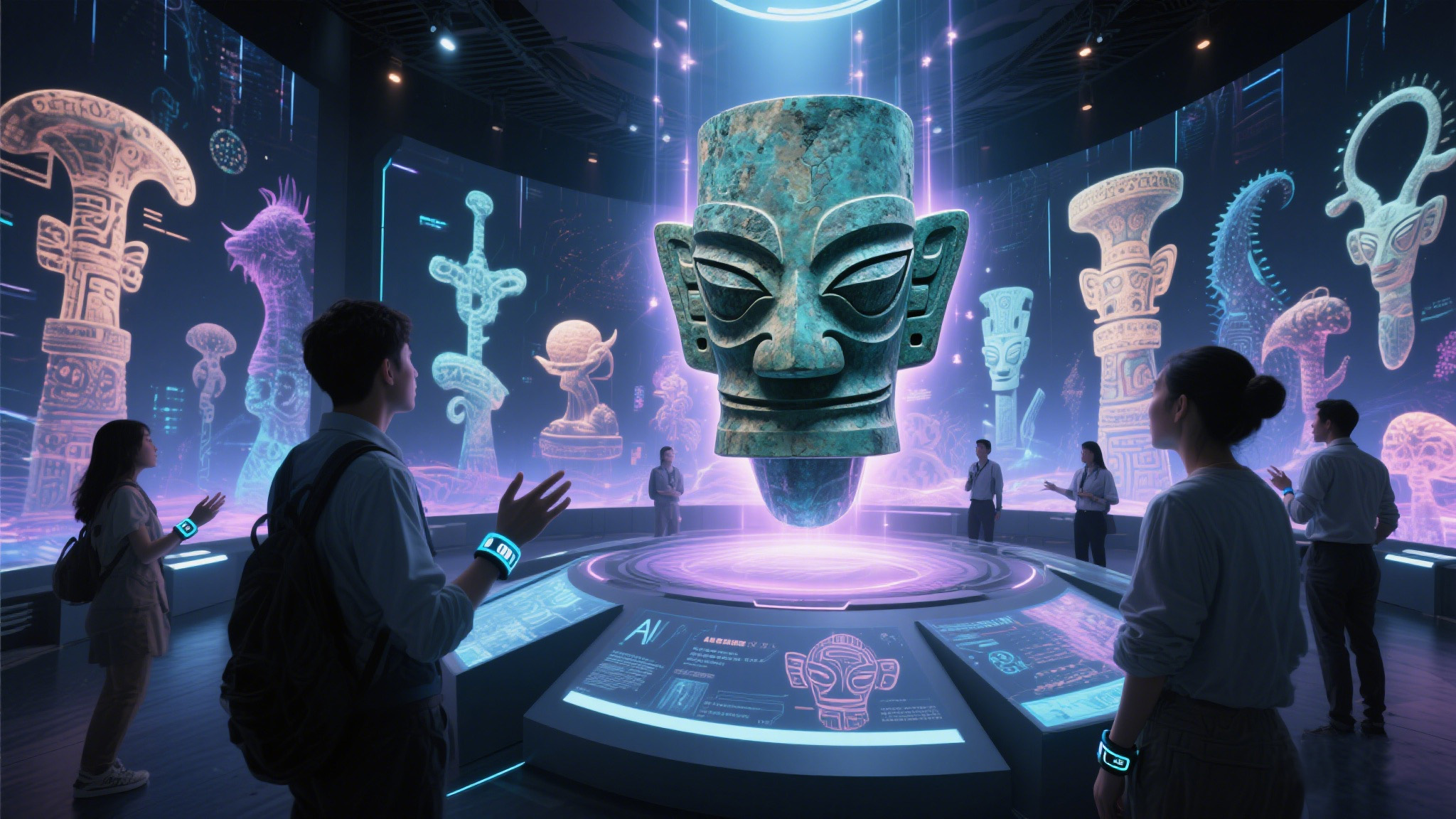Digital Scenic Spots: Transforming Tourism Through Technological Upgrades
江浸月 2025-06-10
In recent years, the integration of advanced technologies has revolutionized the tourism industry, particularly in scenic spots. Digital scenic spots, empowered by innovations like 5G, AI, IoT, VR/AR, and smart systems, are redefining visitor experiences while enhancing operational efficiency and sustainability.
In recent years, the integration of advanced technologies has revolutionized the tourism industry, particularly in scenic spots. Digital scenic spots, empowered by innovations like 5G, AI, IoT, VR/AR, and smart systems, are redefining visitor experiences while enhancing operational efficiency and sustainability.
Smart Navigation and Immersive Experiences
Modern 景区 now deploy AI-powered intelligent guides to offer personalized services. For example, the Palace Museum in Beijing has launched an upgraded WeChat mini-program with AR navigation, allowing visitors to "enter" the Hall of Supreme Harmony through their smartphones for detailed virtual tours. In Ganzi, Sichuan Province, AI travel assistants embedded in apps generate customized itineraries based on voice commands, while AI photography modules create virtual travel content for tourists. Meanwhile, VR/AR technologies are transforming static displays into interactive adventures. The Xixia Imperial Mausoleums use OLED screens to project 3D holograms of cultural relics, enabling visitors to explore intricate details through gesture controls. At the Jinci Temple in Shanxi, VR headsets provide lifelike tours, reducing physical foot traffic and protecting fragile heritage.
IoT-Driven Management and Sustainability
The Internet of Things (IoT) has become a backbone for efficient 景区 management. Huangshan’s Tunxi Old Street employs a 5G-powered IoT platform with 7,000 monitoring devices to detect fires in real time, cutting response time by 30%. In Lijiang, over 1,000 electric bamboo rafts have replaced traditional fuel-powered ones, reducing noise pollution and carbon emissions by 2,492.5 tons annually. Energy-efficient solutions like Donghai County’s "solar-storage-charging" system at Qingsongling Scenic Area integrate solar power and thermal storage to lower energy costs by 63%. These initiatives align with global sustainability goals, showcasing how technology can balance tourism growth with environmental protection.
5G and Big Data for Enhanced Operations
5G networks are enabling real-time data analytics to optimize visitor flows and resource allocation. The Xijiang Miao Village in Guizhou uses 5G to support MR-based "script murder" games, blending virtual narratives with physical environments. Lianyungang’s Huaguo Mountain deploys a 5G+3D visualization platform to monitor real-time visitor numbers, weather conditions, and vehicle routes, facilitating data-driven decisions for crowd control and marketing strategies. Similarly, Kunshan’s Bache Town utilizes AI cameras to analyze tourist behavior, sending 136 capacity alerts in 2023 to ensure safety and comfort.
Digital Twin and Smart Ticketing
Digital twin technology creates virtual replicas of 景区 for holistic management. Tencent Cloud’s 3D visualization system maps infrastructure, traffic, and environmental data, allowing managers to simulate scenarios and improve emergency responses. Smart ticketing systems, projected to reach $31.65 billion globally by 2030, reduce paper waste and enable dynamic pricing. For instance, mobile QR codes and NFC devices streamline entry while providing operators with insights into visitor patterns.
Conclusion
Digital scenic spots represent a paradigm shift in tourism, merging cutting-edge technology with cultural and natural preservation. By embracing 5G, AI, IoT, and renewable energy solutions, 景区 are not only enhancing visitor satisfaction but also fostering sustainable development. As technology continues to advance, the future of tourism lies in creating seamless, personalized, and eco-friendly experiences that bridge the gap between the physical and digital worlds.
Smart Navigation and Immersive Experiences
Modern 景区 now deploy AI-powered intelligent guides to offer personalized services. For example, the Palace Museum in Beijing has launched an upgraded WeChat mini-program with AR navigation, allowing visitors to "enter" the Hall of Supreme Harmony through their smartphones for detailed virtual tours. In Ganzi, Sichuan Province, AI travel assistants embedded in apps generate customized itineraries based on voice commands, while AI photography modules create virtual travel content for tourists. Meanwhile, VR/AR technologies are transforming static displays into interactive adventures. The Xixia Imperial Mausoleums use OLED screens to project 3D holograms of cultural relics, enabling visitors to explore intricate details through gesture controls. At the Jinci Temple in Shanxi, VR headsets provide lifelike tours, reducing physical foot traffic and protecting fragile heritage.
IoT-Driven Management and Sustainability
The Internet of Things (IoT) has become a backbone for efficient 景区 management. Huangshan’s Tunxi Old Street employs a 5G-powered IoT platform with 7,000 monitoring devices to detect fires in real time, cutting response time by 30%. In Lijiang, over 1,000 electric bamboo rafts have replaced traditional fuel-powered ones, reducing noise pollution and carbon emissions by 2,492.5 tons annually. Energy-efficient solutions like Donghai County’s "solar-storage-charging" system at Qingsongling Scenic Area integrate solar power and thermal storage to lower energy costs by 63%. These initiatives align with global sustainability goals, showcasing how technology can balance tourism growth with environmental protection.
5G and Big Data for Enhanced Operations
5G networks are enabling real-time data analytics to optimize visitor flows and resource allocation. The Xijiang Miao Village in Guizhou uses 5G to support MR-based "script murder" games, blending virtual narratives with physical environments. Lianyungang’s Huaguo Mountain deploys a 5G+3D visualization platform to monitor real-time visitor numbers, weather conditions, and vehicle routes, facilitating data-driven decisions for crowd control and marketing strategies. Similarly, Kunshan’s Bache Town utilizes AI cameras to analyze tourist behavior, sending 136 capacity alerts in 2023 to ensure safety and comfort.
Digital Twin and Smart Ticketing
Digital twin technology creates virtual replicas of 景区 for holistic management. Tencent Cloud’s 3D visualization system maps infrastructure, traffic, and environmental data, allowing managers to simulate scenarios and improve emergency responses. Smart ticketing systems, projected to reach $31.65 billion globally by 2030, reduce paper waste and enable dynamic pricing. For instance, mobile QR codes and NFC devices streamline entry while providing operators with insights into visitor patterns.
Conclusion
Digital scenic spots represent a paradigm shift in tourism, merging cutting-edge technology with cultural and natural preservation. By embracing 5G, AI, IoT, and renewable energy solutions, 景区 are not only enhancing visitor satisfaction but also fostering sustainable development. As technology continues to advance, the future of tourism lies in creating seamless, personalized, and eco-friendly experiences that bridge the gap between the physical and digital worlds.
















